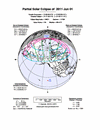- - text and links as of last publication - -
![]()
| CAUTION! OBSERVING A SUN ECLIPSE IS DANGEROUS AND MAY CAUSE IRREVERSIBLE EYE DAMAGE, UP TO BLINDNESS, ANNULAR AND PARTIAL ECLIPSES INCLUDED! Observing a Sun eclipse necessitates DEDICATED SAFE TECHNIQUES! |
The second eclipse of 2011 is another solar eclipse and a partial one still. It mostly runs over the desolated areas of the Russian Far East and northernmost North America as the sole most inhabitated regions concerned being northeastern Canada, Iceland, or northern China and Japan. Northern Alaska is also concerned. For the few people there, the eclipse in some places has the midnight Sun involved. A partial solar eclipse occurs when neither the 'umbra' nor the 'antumbra' of the eclipse touches Earth in any place as the 'penumbra' does, only. Anywhere in the area of a partial solar eclipse, observers are treated with a Sun indented by the dark disk of the Moon. for more about the solar eclipses, theoretically, see our tutorial "Sun Eclipses"
Eclipse's greatest is occurring at 21:16:11 UT, the more North in the area of the eclipse, the more the Sun indented by the disk of Moon. The theoretical maximum of the eclipse occurs with a magnitude of 60 percent as inhabited areas concerned are with a 15 to 25 percent occultation, or about 46 in Iceland. The Far East has the eclipse by sunrise as Canada or Iceland by sunset as in northern North America the southern limit of the penumbra falls along a curve from south of Fairbanks to central New Brunswick and Nova Scotia
 | The June 1st, 2011 Partial Solar Eclipse as it will look like as seen from Reykjavik, Iceland. picture site 'Amateur Astronomy', based on Stellarium |
Eclipse's main data are the following (data as of November 2010, F. Espenak, NASA/GSFC). The Moon's apparent diameter will be of 30' 26.8", compared to the Sun's 31' 32.6". for more about how to observe a solar eclipse, see our tutorial "Observing a Sun Eclipse ":
- greatest eclipse: 21:16:11.1 UT
- eclipse magnitude (fraction of the Sun's diameter obscured by the Moon at greatest eclipse): 0.6011
- P1 to P4 (moments of first-last external-internal tangency of the penumbra with Earth's limb; practically these are the moments of the eclipse for the places where the eclipse is partial); in UT: P1 at 19:25:18.3, P2 at 23:06:56.2 (no P2 nor P3 times as the cone of the penumbra is not entirely contained upon Earth's disk)
 | see a map for the June 1st, 2011 Partial Solar Eclipse. map courtesy Fred Espenak - NASA/GSFC |
. for more about this eclipse and for more about solar and lunar eclipses generally, you may see at Fred Espenak's NASA's eclipse website
Observation Reports: no special report was made about that eclipse
Website Manager: G. Guichard, site 'Amateur Astronomy,' http://stars5.6te.net. Page Editor: G. Guichard. last edited: 1/1/2011. contact us at ggwebsites@outlook.com